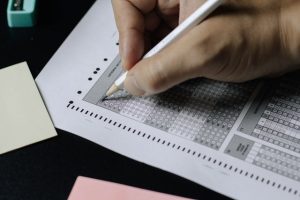Toolkit
"Toolkit enables students and instructors to receive constant feedback and to know whether important material is being grasped.
As an added bonus, a bank of essential information students can refer to is generated. "

What is it?
Toolkit is an instructional strategy whose primary purpose is to assist students in consolidating the knowledge they have acquired over the course of a unit/module and potentially over the course of an entire semester. It is generally carried out at the end of each session and allows students to briefly revisit the material covered that day so that essential practical strategies and approaches can be identified. The tools (or strategies) identified by the class can then be collected in a variety of fashions (e.g., in a designated section of their notebooks or within an online collaborative platform). Students are then expected to organize this material, thus generating their toolkit(s) on their own. The toolkit can be organized in a variety of formats (a journal, spreadsheet, concept map, a portfolio of information consisting of multiple formats, etc.).
If carried out regularly over the course of a semester, a toolkit will provide students with a powerful bank of information/tools they can refer to in completing assignments and in studying for their assessments. Putting the toolkit together helps students to link all the different aspects of the class and all the content they have encountered. Furthermore, this process helps them to see that new content often builds on previously encountered material.
Skills Promoted
- Knowledge organization
- Knowledge integration
- Metacognition
- Self-regulation
Who's using it?
SALTISE community members who use this strategy and are willing to share advice and/or resources.
| Institution | Discipline | Instructor | Classroom settings |
|---|---|---|---|
|
McGill University Level: University |
Chemistry |
Traditional Classroom Classroom size: All sizes |
|
|
Dawson College Level: College |
Chemistry |
Traditional / Active Learning Classroom Classroom size: 30-40 |
|
|
Dawson College Level: College |
Physics |
Active Learning Classroom Classroom size: 30-40 |
| Institution |
McGill University Level: University |
Dawson College Level: College |
Dawson College Level: College |
|---|---|---|---|
| Discipline |
Chemistry |
Chemistry |
Physics |
| Instructor | |||
| Classroom settings |
Traditional Classroom Classroom size: All sizes |
Traditional / Active Learning Classroom Classroom size: 30-40 |
Active Learning Classroom Classroom size: 30-40 |
Why use it?
The toolkit strategy enables me to see what students have really retained at the end of a session and what concepts they consider to be the most important. Thus, I can quickly see if student learning meets expectations and if students have truly grasped and identified the important concepts. If ever this is not the case, I can immediatley revisit the necessary content at the start of the next session. Furthermore, I know to immediately modify and improve the activities carried out during the session. Thus, toolkit is a good way to assess ones own activities and lesson plans.
Beyond this, students have the opportunity to assemble and organize their own personalized toolkit. They can refer back to their toolkit throughout the semester (e.g., when they are completing assignments or studying for their tests). It’s really a win-win situation.
(Tim Miller, Dawson College)
Time constraints. The toolkit exercise is carried out at the end of class and should be brief. However, it often sparks new questions and potentially rich discussions. As a result, it may leave the students hanging, as they don’t get the answer right away. Should this occur, it is important to briefly revisit the discussion the following class to answer student questions. Likewise, the discussion surrounding the major take-aways can result in the conception of a new activity. For example, the instructor can ask students to research the content surrounding the questions that come up and to return the following class with some answers. Again, the instructor must remember to revisit the topic next class.
At times, the questions brought up by students at the end of one session will foreshadow the material that will be covered during the subsequent session. This further emphasizes the continuity and fluidity of each session to the students.
(TIm Miller, Dawson College)
Ready to try it out?
Toolkit is a consolidation strategy that is generally applied at the end of each session. Approximately 10 minutes from the end of class (i.e., once the instructor has orchestrated an entire session), the following steps are carried out:
STEP 1: Instructor provides students, at the end of a series of lessons/activities, with a template to support their identification and consolidation of the major intellectual tools learned and used in the preceding lessons.
STEP 2:In groups, students discuss the lesson content and identify use-case examples of discipline-relevant: principles, themes, rules/algorithms/heuristics (i.e. underlying relationships and exceptions), etc.
NOTE: this can also be done individually.
STEP 3: In groups, students present their list to the whole class.
STEP 4: Instructor provides feedback on the relevance of the items to be included in the Toolkit list and guides students in their review, evaluation and decisions making.
STEP 5: As a class, students discuss, evaluate and justify decisions for entry of times into a single list.

Strategy Workflow
Helpful resources
References
Barab, S. (2014). Design-based research: A methodological toolkit for the learning scientist. Handbook of the Learning Sciences.
Fill, F. (2005). A learning design toolkit to create pedagogically effective learning activities. Journal of Interactive Media in Education..
Dyckhoff, A. L., Zielke, D., Bültmann, M. and Chatti, M. A. (2012). Design and implementation of a learning analytics toolkit for teachers. Educational Technology & Society.
Klenowski, V., Askew, S., Carnell, E. and (2006). Portfolios for learning, assessment and professional development in higher education.. Assessment & Evaluation in Higher Education.
Videos
TO LEARN MORE
For more resources to Articles and Books





